Take a Trip to Haven — The Free City
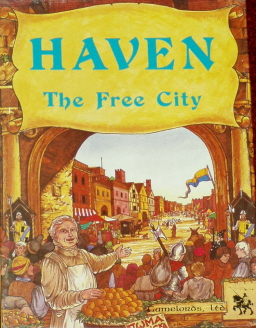 In the early days of role playing, rule systems were plentiful. Really, you couldn’t set foot in a game shop without tripping over a new RPG system. Every game company on the planet was trying to grab a piece of the rapidly-exploding market with a new game focused on pirates, science fiction, the Bronze Age, the Wild West, King Arthur, horror movies, the fall of Moria, the Federation, Middle Earth, Jack Vance’s Dying Earth, Judge Dredd’s Mega-City One, the Marvel Universe… heck, there were even role playing games about high school, fer cryin’ out loud.
In the early days of role playing, rule systems were plentiful. Really, you couldn’t set foot in a game shop without tripping over a new RPG system. Every game company on the planet was trying to grab a piece of the rapidly-exploding market with a new game focused on pirates, science fiction, the Bronze Age, the Wild West, King Arthur, horror movies, the fall of Moria, the Federation, Middle Earth, Jack Vance’s Dying Earth, Judge Dredd’s Mega-City One, the Marvel Universe… heck, there were even role playing games about high school, fer cryin’ out loud.
Supplements? They were a dime a dozen. Virtually every one of the systems above had at least half a dozen. Want the complete scoop on Midgard? Wolfgang Baur has you covered. Desperately need advice on how to survive in a dungeon? Check. Or how about a trip to the mysterious lost Empire of the Aztecs?
Adventures? Lordy, yes. Countless fabulously detailed adventures, from Gygax’s classic The Temple of Elemental Evil; to the home of King Kong, Monster Island; to the ruins of Parlainth, an ancient capital that vanished from the face of the Earth; to Call of Cthulhu scenarios based on actual tales by H.P. Lovecraft. You couldn’t throw a stick without bouncing off half a dozen epic adventures.
Was there anything an avid gamer couldn’t find, in the first heady decades of our hobby?
Yes, there was. If there was anything as scarce as hen’s teeth, it was a thriving, living city setting.
And no wonder. Ruined cities, they were a cinch. Pretty map and an encounter key. But an inhabited city? With a functioning economy, logically consistent government, sinister underworld, bustling marketplaces, and larger-than-life heroes, villains, and just plain folk going about their business? That took a level of imagination — and commitment to design — on a whole new scale.
There were a few attempts at city settings, some better than others. But for my money, the most successful, and easily one of the most ambitious, was Gamelord’s marvelous Haven — The Free City.
Gamelords
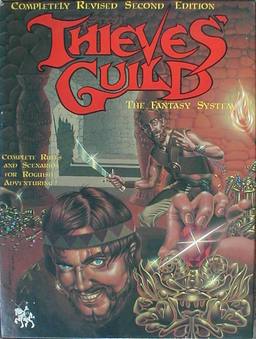 Gamelords was one of the most innovative and unusual game companies to emerge in the late 70s. They began with a series of well-received adventures and supplements, like The Lost Abbey of Calthonwey (1979) and The Complet Tavern (1980).
Gamelords was one of the most innovative and unusual game companies to emerge in the late 70s. They began with a series of well-received adventures and supplements, like The Lost Abbey of Calthonwey (1979) and The Complet Tavern (1980).
Their first major release — and the one that really put them on the map — was Thieves’ Guild (1980), a standalone set of rules focused on thieves in an urban setting. Anyone who’s read Fritz Leiber’s Hugo-winning story “Ill Met in Lankhmar,” which details how his heroes Fafhrd and the Gray Mouser first met, understands the instant appeal of a system that allows thieves to live up to their true potential, and includes details on that most secretive of organizations: the Thieves’ Guild.
Years after Gamelords folded, Conan D. Kerry offered a little background on the genesis of both Thieves’ Guild, and the company behind it:
Way before Gamelords was founded, my father ran a campaign out of a bookstore called ‘The Chimera.’ He was always into gaming in just about any form and was quite passionate about it. One of his complaints was that the thief class only had 2 purposes in D&D:
1. Find traps
2. Cannon fodderHe wrote a gaming system that expanded on the thief class, and thus Thieves’ Guild was born. Gamelords was formed by my father [Kerry Lloyd], Rich Meyer, Janet Troutvetter and Michael Watkins. If you look at the address for Gamelords, it was Grosbeak Terrace, also known as our house.
Due to not enough sales and monetary issues, the rights were sold to Chaosium (Tadashi Ehara) in 1986.
Thieves Guild was designed by Richard Meyer and Kerry Lloyd, and originally released in ultra low-budget format as a collection of loose-leaf, three-hole punched pages with a minimalist, black-and-brown cover.
Even in that rough package it proved popular immediately, and Gamelords supported it with an impressive line of ten supplements (see the complete list here, and a delightful overview of the system at Beyond the Black Gate), published at regular intervals and available by subscription. Here’s a typical magazine ad from the early 80s (click for bigger version):
The Free City of Haven
But what the system really cried out for was a richly developed urban setting worthy of the new rules system… and in 1981 Richard Meyer and Kerry Lloyd delivered.
The first edition of their sprawling city was titled The Free City of Haven (note the slightly different title). Like the original Thieves Guild, it was three-hole punched and colored with what appeared to be crayon, which kind of gave it the look of a school project.
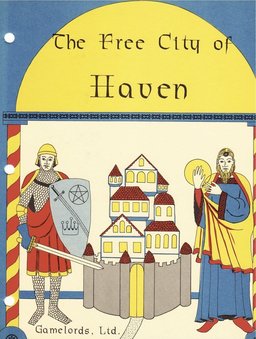 Still, once you got past the cheap packaging, The Free City of Haven delivers all kinds of wonders. The zip-lock bag came with a huge, fold-out color map of the city, sectioned off into boroughs with names like the Outlands, Commons, and North Corridor — and a dangerous nest of curving streets in the slums called the Labyrinth.
Still, once you got past the cheap packaging, The Free City of Haven delivers all kinds of wonders. The zip-lock bag came with a huge, fold-out color map of the city, sectioned off into boroughs with names like the Outlands, Commons, and North Corridor — and a dangerous nest of curving streets in the slums called the Labyrinth.
Haven was clearly intended to be a home base for adventuring parties of all types, and it carefully avoided the kinds of quirks or tricky geography that would prevent a Game Master from plopping it down on her campaign map anywhere she felt like. But that didn’t mean it didn’t have personality. It had things like a city-wide Centaur Trolley, a group of politically disaffected dwarves meddling in the local government, a massive open air market, and much more.
It also came packed with marvelous detail, on a wide variety of shops, taverns, meeting places, random encounters — and lots and lots of non-player characters (300 in all). In fact, if anything those loose-leaf pages were too packed, with two columns of tiny Courier font that made the whole thing read like a newspaper.
Here’s the back cover copy:
Welcome to the Free City of Haven! If your players are looking for a place to spend their hard earned gains from their last expedition – seeking to establish a more permanent base of operations for their favorite adventurers – or are just plain tired of skulking around uncharted dungeon corridors for the twentieth week in a row-then bring them to Haven, the biggest and best fantasy city ever published.
In these pages, GMs will find complete details on over 100 distinctive shops, 60 random encounters, and 300 NCPs from all walks of life – from the noble Young Stallions, and the dissident dwarven artisans bidding for political influence, to the lowly commoners who toil in the city’s factories – and including lawyers and judges, priests and princelings, and courtesans and constables. But Haven — unlike previous city gaming aids — is much more than just random encounters! Over 25 complete scenarios are outlined in the Free City, guaranteed to provide your players with dozens of hours of challenging adventure, as they try to find the missing heir of a reknowned hobbit adventurer, match wits with the con artists at the open air bazaar, Trade Island, or seek to uncover the papers that reveal the High Judge’s incriminating secret!!!
Haven can be used with any fantasy playing rules system that accept the existence of magic, and assumes that a diverse set of races can live together in comparative (and we do mean comparative) harmony. To this end, ample space is provided within Haven’s boundaries to allow GMs to incorporate features from their own universes (religious or political factions, even NPCs) into the city. This full color map illustrates the overall layout of the city, and identifies over 100 important landmarks. It in turn is supplemented by eleven detailed neighborhood maps, which display major areas of activity like the Street of Silk Veils (home of sensuous entertainments), Trademasters Square (center of government and justice) and the neighborhoods of the Dell, Dwarrow, and Erinhir (where the city’s hobbits, dwarves, and elves work, play and reside).
So plunk down a few paltry shekels, and walk through the gates of the fair Free City -you’ll wonder why you ever stayed anywhere else!”
The next release for Haven abandoned the loose-leaf format for a more typical saddle-stitched booklet, and much superior cover art. In fact, Haven: Secrets of the Labyrinth (1983) is a superior release in almost every way. It expanded on Haven with details on regions beyond the city walls, the notorious Black Hand Guilds, the Horse Market, mercenary companies in the city, and several intriguing scenarios, including The Renegade Prince and The Bartered Brides. It also includes some excellent interior spot art.
In HAVEN – The Free City, gamers were introduced to the bustling trade city of Haven, where opportunities for adventure, intrigue, and excitement waited on every street corner. Now the saga of the city continues in
HAVEN – Secrets of the Labyrinth
In this second volume of the HAVEN series, GMs will find detailed descriptions of over 120 shops, taverns and residences, numerous random encounters, and hundreds of NPCs, creating an ever-changing tapestry of events, personalities, conflict and intrigue. Players can join up with a mercenary company or a caravan traveling to distant lands, dare to venture into the notorious Labyrinth, the thieves’ quarter of Haven, or become embroiled in the deadly rivalry between the Thieves’ Guild and the sinister Black Hand. Over a dozen scenarios are outlined for the GM’s convenience, to provide hours of adventuring as the players become involved in the struggle of an exiled elvish prince to avoid capture and regain his throne, or the race to save a transformed son of a noble family from a fate worse than death in the Horse Market.
Each volume in the HAVEN series can be used with any fantasy role-playing system that accepts the existence of magic and a multi-racial universe, and is designed to be an interrelated series with Thieves’ Guild, forming the basis for a complete campaign universe; however, each can also be used independently of the others. Space is provided for the GM to incorporate features, politics and personalities from his own campaign into the fabric of the city. Secrets of the Labyrinth also includes 10 detailed neighborhood maps, completing the entire south side of the city, and showing such areas of interest as the South Docks, where the ships of many lands come with their fabulous cargos, the colorful bazaar called the Thieves’ Market, and the forbidding towers in the city’s prison, the Gray Halls.
So let your players become part of the continuing saga in HAVEN – The Secrets of the Labyrinth – the latest jewel in the story of the biggest and best fantasy city ever published.
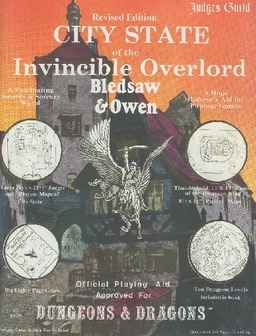 Haven was eventually re-released in a revamped second edition in 1984. Gone were the loose-leaf pages and the stiff cover art; the second edition came in a handsome box, containing seven individual booklets, one for each borough, and a separate booklet just for random encounters. The title changed too, to Haven — The Free City. Perhaps more interesting, the back cover text was modified to begin with:
Haven was eventually re-released in a revamped second edition in 1984. Gone were the loose-leaf pages and the stiff cover art; the second edition came in a handsome box, containing seven individual booklets, one for each borough, and a separate booklet just for random encounters. The title changed too, to Haven — The Free City. Perhaps more interesting, the back cover text was modified to begin with:
In this first of three volumes in the chronicles of the city of Haven, GMs will find more than enough material for many months of urban adventuring…
Alas, the planned next installments never materialized. Gamelords, overextended supporting Thieves’ Guild, Haven, and their ambitious line of Traveller books, folded a year later. The assets were sold to Tadashi Ehara of Chaosium. To my knowledge, Ehara did nothing with them.
Now, I enjoy reading adventures. In many ways they’re like proto-novels… or perhaps a more accurate metaphor is a cookbook. The recipe is laid out for you, along with a tantalizing pic or two of how things could turn out. It doesn’t take a particularly vivid imagination to visualize the kinds of adventures your players could have in Haven. If, like me, you’re the kind of person who enjoys reading well-crafted RPG products, Haven is particularly rewarding: rich with plot hooks and loosely-linked scenarios, with well-developed characters and intriguing, believable situations.
Other Early Fantasy Cities
Haven wasn’t the only game in town if you were interested in a city setting for your early fantasy campaign. The earliest fantasy city — and perhaps the most famous — is of course Judge’s Guild’s City State of the Invincible Overlord, a vast and sprawling urban center that nevertheless never seemed as logically consistent or believable as Haven to me. City State was originally published in 1976; Mayfair bought the rights from Judge’s Guild and produced a much revamped second edition in 1987. The rights were eventually acquired by Necromancer Games, who released it as a 288-page hardcover in 2004 (now out of print, sadly).
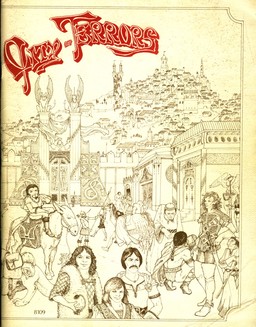 One of my favorite fantasy cities, City of Terrors from Flying Buffalo, was a terrific urban setting released way back in 1978. It didn’t get the exposure it deserved, however; unlike the others on this list, City of Terrors was a solo adventure for Flying Buffalo’s RPG Tunnels and Trolls, so it wasn’t really useful as an aide for other games (it was an absolute blast to read though!) It was written by Michael Stackpole, and packed with artwork by the great Liz Danforth.
One of my favorite fantasy cities, City of Terrors from Flying Buffalo, was a terrific urban setting released way back in 1978. It didn’t get the exposure it deserved, however; unlike the others on this list, City of Terrors was a solo adventure for Flying Buffalo’s RPG Tunnels and Trolls, so it wasn’t really useful as an aide for other games (it was an absolute blast to read though!) It was written by Michael Stackpole, and packed with artwork by the great Liz Danforth.
As time marched on the dearth of city settings became less pronounced. Chaosium released a boxed set outlining the city of Sanctuary, where all the action in the Thieves World books took place, and TSR did an entirely respectable job of adapting one of the most famous fantasy cities ever imagined, Fritz Leiber’s Lankhmar, with a gorgeous cover by Keith Parkinson.
Midkemia Press — whose authors included Stephen Abrams and an young aspiring novelist named Raymond E. Feist — published an exceptional line of urban settings, including City of Carse (1980) and the sea town Tulan of the Isles (1981). Feist set most of his early, highly-regarded fantasy novels in the world of Midkemia, including Magician, the first book of the Riftwar Saga, published way back in 1982.
TSR also fleshed out the Forgotten Realms with the city of Waterdeep, and in 1999 released one of the best fantasy cities ever published: Skullport, an underground city more than a mile beneath Waterdeep which I described as “a lawless den of slave traders, pirates, and demi-humans, where illithids, drow, beholders and less savory creatures traffic with merchants and buccaneers from the surface” in my review for SF Site.
Another underground city — this one considerably more famous — was the Drow metropolis Menzoberranzan, featured in R.A Salvatore’s bestselling novels and released in a deluxe boxed set by TSR in the early 90s.
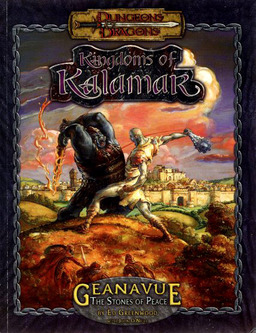 I even wrote a city a few years ago. Co-wrote, I should say, with Ed Greenwood, creator of the Forgotten Realms. Geanavue: The Stones of Peace, a Kingdoms of Kalamar Sourcebook for Dungeons and Dragons, was released by Kenzer and Company in 2002. Ed did most of the writing; I designed the rumor system meant to gradually unveil the secrets of the city to the players as they wandered its streets, and worked with my friend Todd Ruthman to design an underground sewer filled with nasty surprises.
I even wrote a city a few years ago. Co-wrote, I should say, with Ed Greenwood, creator of the Forgotten Realms. Geanavue: The Stones of Peace, a Kingdoms of Kalamar Sourcebook for Dungeons and Dragons, was released by Kenzer and Company in 2002. Ed did most of the writing; I designed the rumor system meant to gradually unveil the secrets of the city to the players as they wandered its streets, and worked with my friend Todd Ruthman to design an underground sewer filled with nasty surprises.
The Free City of Haven (First Edition) was written by Richard Meyer and Kerry Lloyd and published by Gamelords in 1981. It was shipped in a zip-lock bag and consisted of 128 loose-lead pages, a full-color fold-out map, and a bunch of detailed smaller maps on heavy cardboard stock. According to the slender catalog I found inside, it retailed for $16.95. Copies of this edition are relatively inexpensive; mint condition copies routinely sell on eBay for $10-$15.
Haven — Secrets of the Labyrinth was written by Kevin Hardwick, Kerry Lloyd, Richard Meyer, and Janet Trautvetter, and published by Gamelords in 1983. It was 96 pages in softcover.
Haven — The Free City (Second Edition boxed set) was written by Kerry Lloyd, Richard Meyer, Larry Richardson, Janet Trautvetter, Michael Watkins, and Michael Welker, and published by Gamelords in 1984. The box contained 9 booklets, 10 detailed neighborhood maps, and a poster-sized color map. Copies of this edition are also inexpensive; I bought a nice set of both the boxed second edition and Secrets of the Labyrinth on eBay last month for $15.
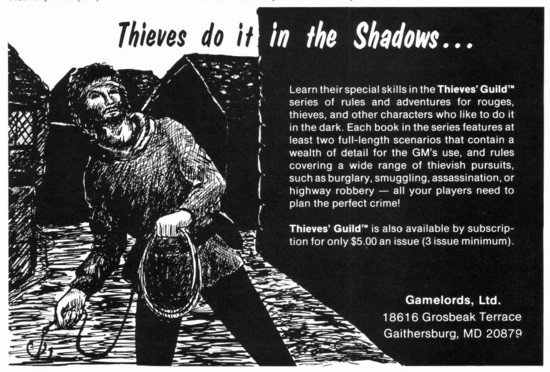
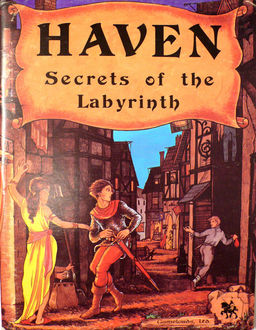
Often times, Cities and other polities are just places to refresh and sell loot before going back into the dungeon again.
The strangely abstracted TORCHBEARER makes that even more explicit.
I always liked city based games and modules, however. Waterdeep, Lankhmar, Sanctuary…I owned many of them.
No love for Freeport, though?
John, thanks for this one, and all the nostalgia pieces. Love them.
As a game master, I always found running a D&D city-based campaign to be a bit taxing on the imagination, at least after a while. Once the characters got past 5th level or so, they simply became too powerful to remain in a compact environment for any length of time, and to consistently throw more and more powerful “monsters” at characters within a city can become tedious. Still, it can work with some GM preparation and a considertion for XP beyond simple slaying of monsters and collecting of gold. Anyway, for city campaigns I always preferred a system in which the characters did not become so powerful, or at least not so soon, such as SPI’s Dragonquest.
Great article! I remember Haven — not that I ever owned it, but it was one of many RPG supplements that got glowing reviews in Dragon Magazine back in the day that I really, really wanted but couldn’t lay hands on through the auspices of my local hobby shop.
(Especially because I was always obsessed by cities, especially mapped cities.)
This looks great. I don’t know how we missed it. We actively started playing Dragonquest so we thieves and conmen would really have something to do. Then we used City of the IO so they’d have somewhere to do it.
> Often times, Cities and other polities are just places to refresh and sell loot before going back into the dungeon again.
Prince,
Yeah, very true. When your game is focused on dungeon crawling, it’s actually a plus to have such utility in your urban environments. 🙂
Never met a campaign that couldn’t be improved with a little more color to the urban areas though, even when players are sometimes impatient with it.
> The strangely abstracted TORCHBEARER makes that even more explicit.
Ooooo… I know almost nothing about TORCHBEARER. Always cool to stumble on another dungeon-crawling game, though. Was this thing ever published? Did it just go out to backers, or is there some place interested parties can buy it?
> No love for Freeport, though?
Whoops! Forgot Freeport. One of the greats! I always think of it as a modern pub though, not part of the early days of the industry, like CITY STATE OF THE INVINCIBLE OVERLORD and CITY OF CARSE.
> John, thanks for this one, and all the nostalgia pieces. Love them.
Ty,
Glad you enjoy them!
> As a game master, I always found running a D&D city-based campaign to be a bit taxing on the imagination, at least after a while.
> Once the characters got past 5th level or so, they simply became too powerful to remain in a compact environment for any length of time…
Oh, absolutely. Level inflation was always more of an issue in cities, where the players quickly overshadowed the cast of NPCs I’d created for them.
Still, I found my players really enjoyed a growing rep, and the sense that they were “the toughest guys in town.” What worked for me was to gradually start introducing them to high-level NPCs as they moved up the ranks, and allow those characters to level up as time went by, keeping pace with the players… so that my players always had something to strive for.
> I was always obsessed by cities, especially mapped cities.
Joe,
I know what you mean. It was usually the map that sold me, too. Given enough time, I had the chops to create a fantasy city (and I did, eventually)… but crafting a really detailed city map? That was beyond my skill set, and I looked on them with wonder.
> This looks great. I don’t know how we missed it.
Hey Fletcher! Glad you enjoyed it.
> We actively started playing Dragonquest so we thieves and conmen would really have something to do.
Huh… I didn’t know Dragonquest was such a robust system for thieves. Howard Andrew Jones has been telling me about it for years. I should examine it more closely.
John, Dragonquest gives characters more of a level playing field than does a system like D&D. Regardless of a character’s experience, powers and skills, even low-level threats are just that, a threat. For that reason, it can be much easier to include a beginning character into an old campaign, whereas in D&D it would be suicidal for a 1st level character to join … say, a campaign of 15th level characters. The possible exception to this being beginning mages in DQ, who tend to be fairly puny because their spells don’t always work and sometimes have nasty backfires.
Ah, that explains it. Thanks for the concise explanation!
All this talk of first level thieves has me aching to roll up a character again…
Well John, waiting till August might be a bit long, but it looks like I’ll be flying over to GenCon this year. So if you, Howard and any others turn up I could always run a game of RuneQuest for you guys…
(If you play a thief in the jungles of Monster Island, we could run a sweepstake amongst the core Black Gate readers to see how many hours they think you’ll survive!)
Ah, yes, those intriguing questions about what goes on in PCs’ lives between dungeons crawls… As a DM, I had, frankly, usually glided over such details. But with our current campaign, once the characters were powerful and wealthy enough (around 11th-12th level) they moved into a keep on the outskirts of a small port city (I grabbed the city out of a D&D 3.5 supplement, the name of which is escaping me at the moment).
Well, the wheels start turning… I get to thinking about questions like What about all that time the PCs are away adventuring? There’s a keep full of all their treasure and the magic items they didn’t bring along: it’s a magnet for thieves! So don’t they have to hire NPCs as guards? Maybe set traps?
And what do the city folk and the local government think about these super-powerful characters who’ve moved in next door? Are the PCs seen as celebrities, welcome assets to have around should the port come under attack? Or are they eyed with suspicion as a potential threat?
Nick, I’m thinking any city manager worth his salt is going to see that keep with all its treasure and magical items and think, “annual property tax.” 🙂
Of course he or she will want to have a hefty army or other powerful NPCs as backup.
> Well John, waiting till August might be a bit long, but it looks like I’ll be flying over to GenCon this year.
> So if you, Howard and any others turn up I could always run a game of RuneQuest for you guys…
Pete — awesome! That would be epic. You’ll take it easy on us, right? 🙂
> (If you play a thief in the jungles of Monster Island, we could run a sweepstake amongst the core
> Black Gate readers to see how many hours they think you’ll survive!)
I can just imagine that betting pool… Fultz and Joe H. would take 3:1 odds that I go down in the opening melee, and Ty would win by betting I don’t last 10 minutes against the carnivorous plants…
> And what do the city folk and the local government think about these super-powerful characters who’ve
> moved in next door? Are the PCs seen as celebrities, welcome assets to have around should the port come under
> attack? Or are they eyed with suspicion as a potential threat?
Nick,
Sounds like you’re bringing some real creativity to that campaign. You’ll need to keep us posted on how it all turned out.
Virtually every campaign I’ve ever run started in the dungeon, and (to varying degrees) gradually migrated into an urban setting as the players got more powerful and involved in politics on a local and (eventually) national scale. They start out dreaming about defeating giants, and end up dreaming of ruling a nation. 🙂
> Nick, I’m thinking any city manager worth his salt is going to see that keep with all its treasure and magical items and think, “annual property tax.”
Ty,
Absolutely! Of course, a clever GM can find entirely legal ways to drain that treasure room… I put social pressures on my players to hold tournaments, fund a guild, support the local leaders they liked, etc. Fame has its costs!
>Pete — awesome! That would be epic. You’ll take it easy on us, right? 🙂
Great! I can’t promise I’ll take it easy… but I’ll make sure its fun!
[…] a month ago I wrote an enthusiastic review of Haven — The Free City, a complete fantasy city designed and published by now-defunct Gamelords way back in 1984. One of […]
[…] Take a trip to Haven: The Free City […]